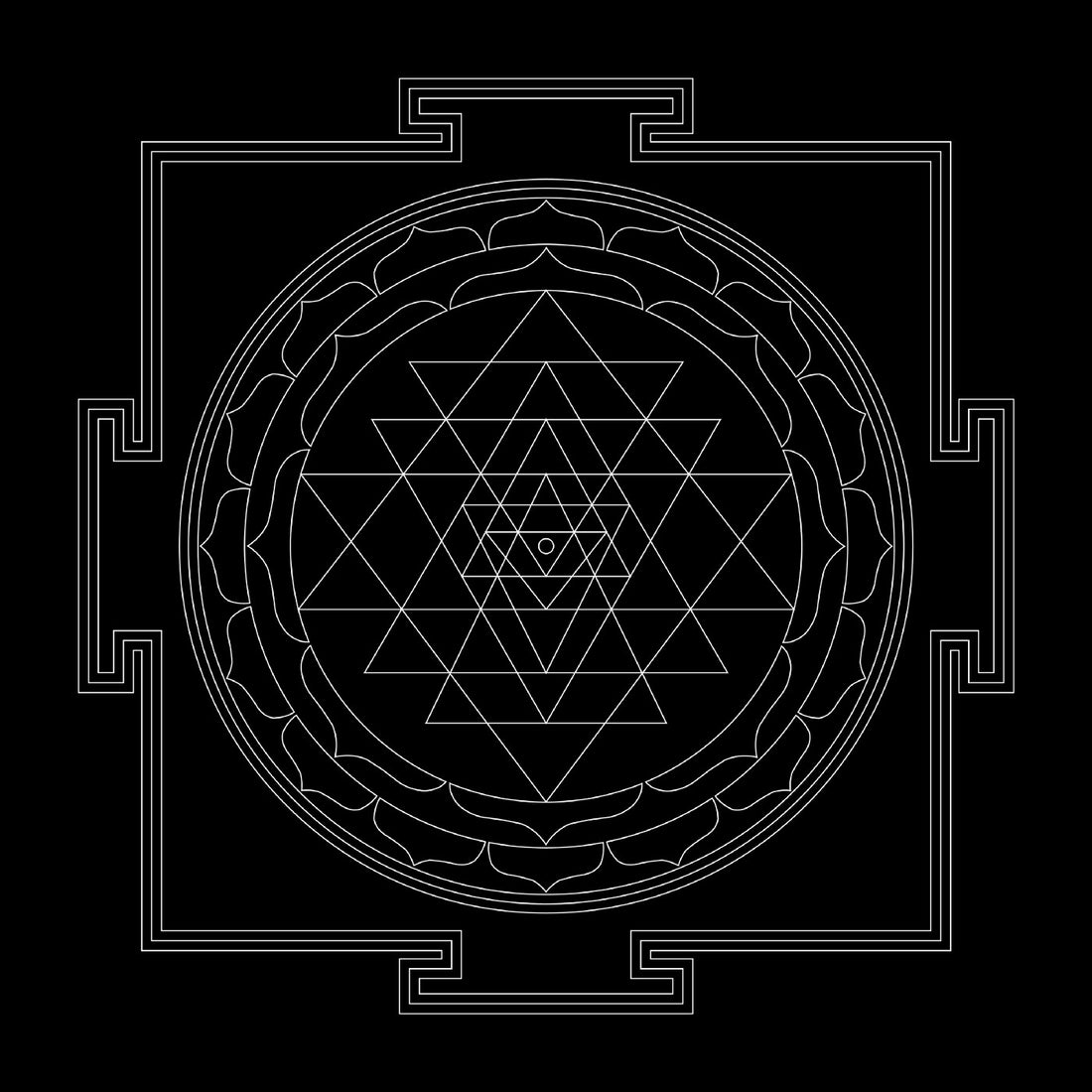A Yantra is a combination of forms created towards a certain purpose. Often made as a geometrical pattern using basic shapes, a Yantra acts as a powerful spiritual symbol and a tool for meditation. Yantras have the capability to enhance our “mental-scape” and the physical body, allowing us to use it in a much better way. They carry deep spiritual significance and provide a focal point that acts as a window into the absolute. When the mind concentrates on a single, element such as the Yantra; mental clutter decreases. The goal is to develop the ability to make the mind remain empty and silent without the Yantra. In the most advanced stages of meditation, it is also possible to attain union with the divine by the visualization of Sacred Geometry in a Yantra.
Used in worship, devotion and meditation; Sri Chakra Yantra is a complex sacred geometry in use for thousands of years with its origin in clouded mystery. It portrays the journey of creation through a powerful matrix that represents both; the universe and the human body. Thus, acting as a cosmic antenna allowing direct access to communicate with the universe. It is one of the most difficult geometrical figures to draw.
__

Nava Avarana (nine enclosures)
The 9 Avaranas/Enclosures that compose the Sri Chakra, are described in the order of absorption (samhara-krama). The Yantra Geometry starts with the outermost enclosure “Bhupura” and leads to “Bindu”, the central point.
__

Bhupura
Also known as Trilokya Mohana Chakra, this is the 4 sided outer wall serving as a protective cover. It includes the entire design of the Yantra just as the Earth supports the entire existence. The 3 concentric circles (trivritta) represent the 3 objectives of life: Dharma, Artha & Kama.
__

Shodasa Dala (16 Petalled Lotus)
The 16 Petalled Lotus is the 2nd enclosure and depicts features of the yantra that aren’t strictly a part of the geometrical shape, but rather a result of the energy contained inside it. The 16 petals relate to the powers in the 5 Elements + 10 senses of perception + the Mind.
__

Ashta Dala (Eight-Petalled Lotus)
This is the 3rd Enclosure with a consonant inscribed within each petal. The petals represent 8 divinities associated with erotic urges, independent of the physical body. These relate to mental pleasures derived through 5 organs and the modalities of mind: rejection, acceptance and indifference.
__

Chaturdasara (Fourteen Triangles)
14 triangles formed by intersection make up the 4th enclosure of the Yantra. The fourteen corners represent the vital forces in the human body. They are also related to the 10 Organs (indriyas) as well as the Mind (Manas), Intellect (Buddhi), Being (Chitta) and Conscious Ego (Ahamkara).
__

Bahirdasara (Outer Ten Triangles)
14 triangles formed by intersection make up the 4th enclosure of the Yantra. The fourteen corners represent the vital forces in the human body. They are also related to the 10 Organs (indriyas) as well as the Mind (Manas), Intellect (Buddhi), Being (Chitta) and Conscious Ego (Ahamkara).
__

Antardasara (Inner Ten Triangles)
This Avarana is the 6th Enclosure and represents the 10 specific fires(vanyaha) within the body. The advent of inner realization begins here. This avarana is significant as it helps in protection from all obstacles during spiritual progress, allowing the devotee to develop an awareness that he is Shiva (the consciousness).
__

Asthakona (Eight Triangles)
In the 8 triangles formed by this figure, 8 divinities presiding over speech reside. Between them, all the alphabets in Sanskrit grammar are covered. These energies also rule over contradictions in life such as cold and heat; happiness and sorrow. This enclosure has the power to eradicate the most basic diseases.
__

Trikona (Triangle)
This primary triangle with its apex facing down(east) is the 8th enclosure surrounding the central point (bindu). The three angles of the triangle represent three forms of speech and the 3 powers; Will, Knowledge and Action. The three corners of the triangle stand for the three dimensions of all existence.
__

Bindu (centre point)
This 9th Avarna is not an enclosure but is the central dimensionless point, the Bindu. It is independent of the intersecting triangles and represents the sanctum of a temple. The Bindu in reality is the Sri Chakra itself and refers to the individual’s consciousness (buddhi) which is beyond the body-mind complex.
__
Know more about the Sri Chakra Yantra and view our first collection of spiritual tools for your wellness space — YANTRĀ

